
The Amethyst Ring by Scott O'Dell is the third novel in the historical fiction trilogy started by The Captive and Feathered Serpent.

The Amethyst Ring by Scott O'Dell is the third novel in the historical fiction trilogy started by The Captive and Feathered Serpent.
Julián Estaban, who is impersonating the Mayan god Kukulcán, fights and escapes from a powerful gold hungry conquistador, Hernán Cortés. Kukulcán's followers captured Rodrigo Perdoza, a bishop carrying a message to Cortés to detain Julián. Julián wants to be a priest and asks the bishop many times to make him one, but in the end he lets the Mayan priest sacrifice him, and Julián takes the bishop's amethyst ring. Cortés attacks and captures Kukulcán's city, the City of the Seven Serpents, but Julián escapes to a friendly large village and helps them harvest and trade pearls. He then goes to a smaller trading town and partners with Tzom Zambac and they have a successful feathered cloak business. Fearing betrayal from Tzom, he leaves and eventually finds Francisco Pizarro, a conquistador who is taking a band of Spaniards to get gold from the Inca. They capture the Incan king Atahualpa, who has a room filled with gold to pay his ransom. The Spaniards try and kill him anyway. Julián leaves the group because of his disagreements with the trial. He searches for Chima, a daughter of Atahualpa, whom he has fallen in love with. He finds her and she rejects him because he is a Spaniard. Julián then uses all of his gold to sail back to Seville. There he meets Cantú the Dwarf, who is now very wealthy from gold. Cantú gives Julián a lot of gold, but he joins the Brothers of the Poor and gives it all to them.
The Reading Teacher's review said, "I don't know whether Scott O'Dell's The Amethyst Ring will become a classic, or even whether it will be widely read now. But it is a tantalizing tale, based on a true one... O'Dell lays out mural after mural, telling us what happened in each one, but he's a Sphinx when it comes to pronouncing judgments. That aside, he is a great storyteller and Julián is a great character." [1]
Kirkus Reviews also praised the book, saying that Julián's character development "and the small choices Julian [sic] makes along the way, have remained the compelling focus of a trilogy crackling with intrigue, historical spectacle, and the conflict of cultures that confounds his loyalties." [2]
However, the book was criticized for its treatment of pre-Columbian cultures. Isabel Schon wrote in Journal of Reading, "It is obvious that O'Dell, like many of us, is fascinated with the Mayan, Aztec, and Inca cultures. Thus, I view it as a real tragedy that in The Captive (1979), The Feathered Serpent (1981), and The Amethyst Ring (1983), a trilogy that begins with a pre-Columbian legend, he chose to dwell on only negative aspects of the Mayan culture... The trilogy is indeed a fast moving story of violence and intrigue; it is regrettable, however, that many of its young readers will be exposed to pre-Columbian cultures and the amazing conquest of Mexico through the half-truths and exaggerations of a dilettante historian." [3]
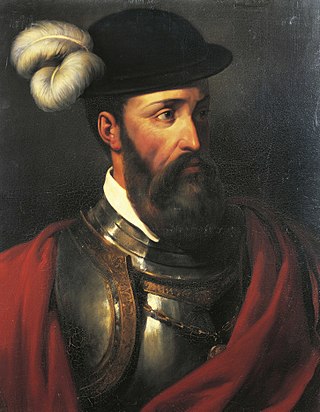
Francisco Pizarro, Marquess of the Atabillos was a Spanish conquistador, best known for his expeditions that led to the Spanish conquest of the Inca Empire.

Miguel León-Portilla was a Mexican anthropologist and historian, specializing in Aztec culture and literature of the pre-Columbian and colonial eras. Many of his works were translated to English and he was a well-recognized scholar internationally. In 2013, the Library of Congress of the United States bestowed on him the Living Legend Award.

Cempoala or Zempoala is an important Mesoamerican archaeological site located in the municipality of Úrsulo Galván in the Mexican state of Veracruz. The site was inhabited mainly by Totonacs, Chinantecas and Zapotecs. It was one of the most important Totonac settlements during the postclassical Mesoamerican period and the capital of the kingdom of Totonacapan. It is located one kilometer from the shore of the Actopan River and six kilometres from the coast.
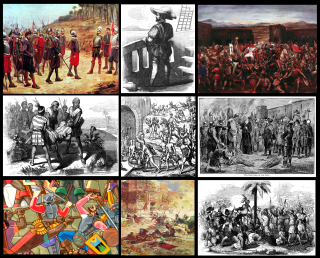
The Spanish conquest of the Inca Empire, also known as the Conquest of Peru, was one of the most important campaigns in the Spanish colonization of the Americas. After years of preliminary exploration and military skirmishes, 168 Spanish soldiers under conquistador Francisco Pizarro, along with his brothers in arms and their indigenous allies, captured the Sapa Inca Atahualpa in the 1532 Battle of Cajamarca. It was the first step in a long campaign that took decades of fighting but ended in Spanish victory in 1572 and colonization of the region as the Viceroyalty of Peru. The conquest of the Inca Empire, led to spin-off campaigns into present-day Chile and Colombia, as well as expeditions to the Amazon Basin and surrounding rainforest.
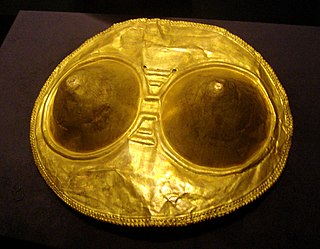
Tumbaga is the name for a non-specific alloy of gold and copper given by Spanish Conquistadors to metals composed of these elements found in widespread use in pre-Columbian Mesoamerica in North America and South America.

El Castillo, also known as the Temple of Kukulcan is a Mesoamerican step-pyramid that dominates the center of the Chichen Itza archaeological site in the Mexican state of Yucatán. The temple building is more formally designated by archaeologists as Chichen Itza Structure 5B18.
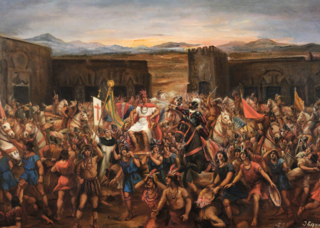
The Battle of Cajamarca also spelled Cajamalca was the ambush and seizure of the Inca ruler Atahualpa by a small Spanish force led by Francisco Pizarro, on November 16, 1532. The Spanish killed thousands of Atahualpa's counselors, commanders, and unarmed attendants in the great plaza of Cajamarca, and caused his armed host outside the town to flee. The capture of Atahualpa marked the opening stage of the conquest of the pre-Columbian civilization of Peru.
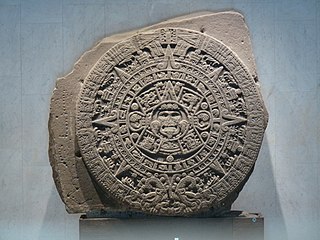
Pre-Columbian art refers to the visual arts of indigenous peoples of the Caribbean, North, Central, and South Americas from at least 13,000 BCE to the European conquests starting in the late 15th and early 16th centuries. The Pre-Columbian era continued for a time after these in many places, or had a transitional phase afterwards. Many types of perishable artifacts that were once very common, such as woven textiles, typically have not been preserved, but Precolumbian monumental sculpture, metalwork in gold, pottery, and painting on ceramics, walls, and rocks have survived more frequently.

The Chincha culture was the culture of a Native Peruvian people living near the Pacific Ocean in south west Peru. The Chincha Kingdom and their culture flourished in the Late Intermediate Period, also known as the regional states period of pre-Columbian Peru. They became part of the Inca Empire around 1480. They were prominent as sea-going traders and lived in a large and fertile oasis valley. La Centinela is an archaeological ruin associated with the Chincha. It is located near the present-day city of Chincha Alta.
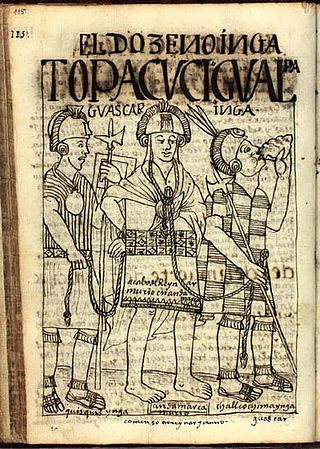
Quizquiz or Quisquis was, along with Chalcuchimac and Rumiñawi, one of Atahualpa's leading generals. In April 1532, along with his companions, Quizquiz led the armies of Atahualpa to victory in the battles of Mullihambato, Chimborazo and Quipaipan, where he, along with Chalkuchimac defeated and captured Huáscar and promptly killed his family, seizing capital Cuzco. Quizquiz later commanded Atahualpa's troops in the battles of Vilcaconga, Cuzco and Maraycalla (1534), ultimately being bested by the Spanish forces in both accounts.

San Gervasio is an archaeological site of the pre-Columbian Maya civilization, located in the northern third of the island of Cozumel off the northeastern coast of the Yucatán Peninsula, in what is now the Mexican state of Quintana Roo. San Gervasio's pre-Hispanic name was Tantun Cuzamil, Mayan for Flat Rock in the place of the Swallows. The ruins were once a hub of worship of the goddess Ix Chel, an aged deity of childbirth, fertility, medicine, and weaving. Pre-Columbian Maya women would try to travel to San Gervasio and make offerings at least once in their lives. In 1560, the Spanish historian, Diego Lopez de Cogolludo, wrote: "The pilgrims arrive at Cozumel for the fulfillment of their vows to offer their sacrifices, to ask help for their needs, and for the mistaken adoration of their false gods." The bishop of Yucatán, Diego de Landa, wrote in 1549 that the Maya "held Cozumel in the same veneration as we have for pilgrimages to Jerusalem and Rome, and so they used to go to visit and offer presents there, as we do to holy places; and if they did not go themselves, they always sent their offerings."
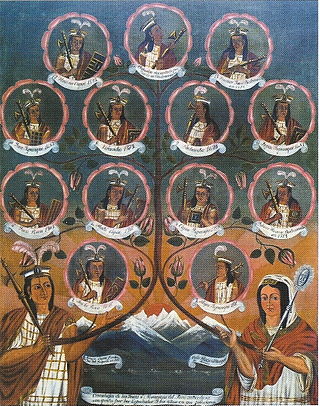
The Incas were most notable for establishing the Inca Empire which was centered in modern-day South America in Peru and Chile. It was about 2,500 miles from the northern to southern tip. The Inca Empire lasted from 1438 to 1533. It was the largest Empire in America throughout the Pre-Columbian era. At the peak of the Inca Empire, it was the largest nation in the world and to this day is the largest native state in the western hemisphere. The Inca civilization was located from north to south of the western hemisphere of South America. The Inca state was known as the Kingdom of Cuzco before 1438. Over the course of the Inca Empire, the Inca used conquest and peaceful assimilation to incorporate the territory of modern-day Peru, followed by a large portion of western South America, into their empire, centered on the Andean mountain range. However, shortly after the Inca Civil War, the last Sapa Inca (emperor) of the Inca Empire was captured and killed on the orders of the conquistador Francisco Pizarro, marking the beginning of Spanish rule. The remnants of the empire retreated to the remote jungles of Vilcabamba and established the small Neo-Inca State, which was conquered by the Spanish in 1572.

The Spanish conquest of the Aztec Empire was a pivotal event in the history of the Americas, marked by the collision of the Aztec Triple Alliance and the Spanish Empire, ultimately reshaping the course of human history. Taking place between 1519 and 1521, this event saw the Spanish conquistador Hernán Cortés, and his small army of soldiers and indigenous allies, overthrowing one of the most powerful empires in Mesoamerica.
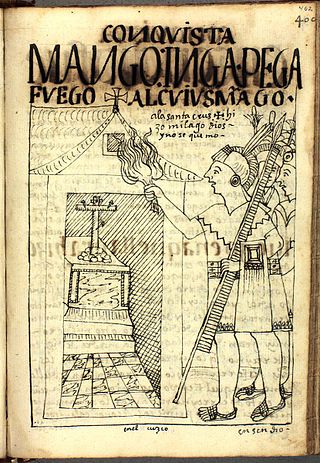
The 10 month siege of Cusco by the Inca army under the command of Sapa Inca Manco Inca Yupanqui started on 6 May 1536 and ended in March 1537. The city was held by a garrison of Spanish conquistadors and Indian auxiliaries led by Hernando Pizarro. The Incas hoped to restore their empire (1438–1533) with this action, but it was ultimately unsuccessful.
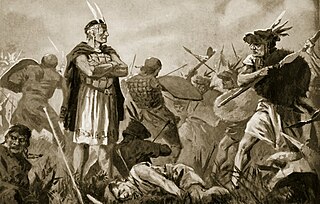
The Inca Civil War, also known as the Inca Dynastic War, the Inca War of Succession, or, sometimes, the War of the Two Brothers, was fought between half-brothers Huáscar and Atahualpa, sons of Huayna Capac, over succession to the throne of the Inca Empire. The war followed Huayna Capac's death.

Los Baños del Inca District is one of twelve districts of the province Cajamarca in Peru. It is centred on a spa which uses the water from thermal springs

Chichén Itzá was a large pre-Columbian city built by the Maya people of the Terminal Classic period. The archeological site is located in Tinúm Municipality, Yucatán State, Mexico.
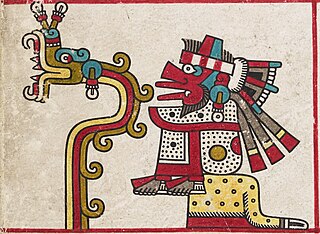
Quetzalcoatl is a deity in Aztec culture and literature. Among the Aztecs, he was related to wind, Venus, Sun, merchants, arts, crafts, knowledge, and learning. He was also the patron god of the Aztec priesthood. He was one of several important gods in the Aztec pantheon, along with the gods Tlaloc, Tezcatlipoca and Huitzilopochtli. The two other gods represented by the planet Venus are Tlaloc and Xolotl.
Francisco Pizarro and his fellow conquistadors from the rapidly growing Spanish Empire first arrived in the New World in 1524. But even before the arrival of the Europeans, the Inca Empire was floundering. Pizarro enjoyed stunning successes in his military campaign against the Incas, who, despite some resistance, were defeated and in 1538 the Spaniards completely defeated Inca forces near Lake Titicaca, allowing Spanish penetration into central and southern Bolivia.

The history of Cusco (Peru), the historical capital of the Incas.